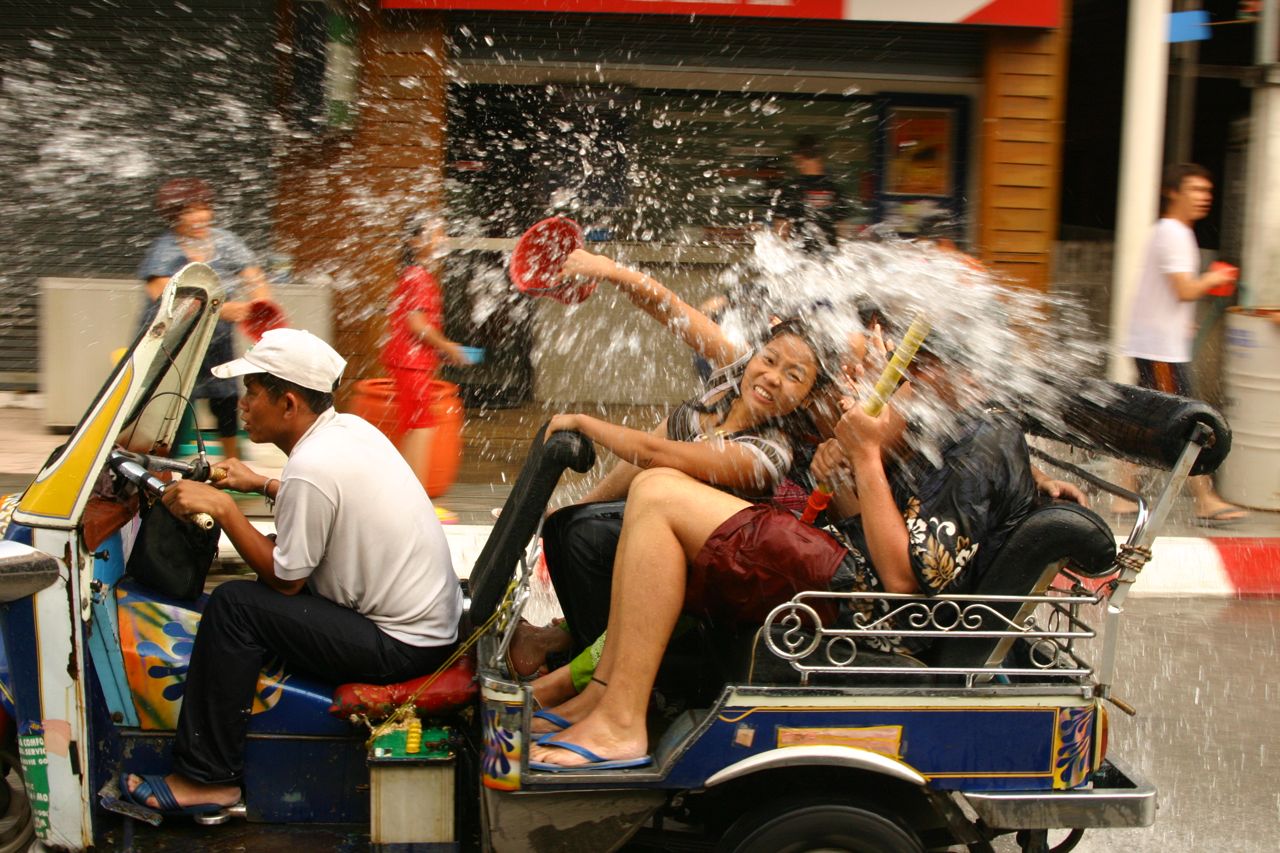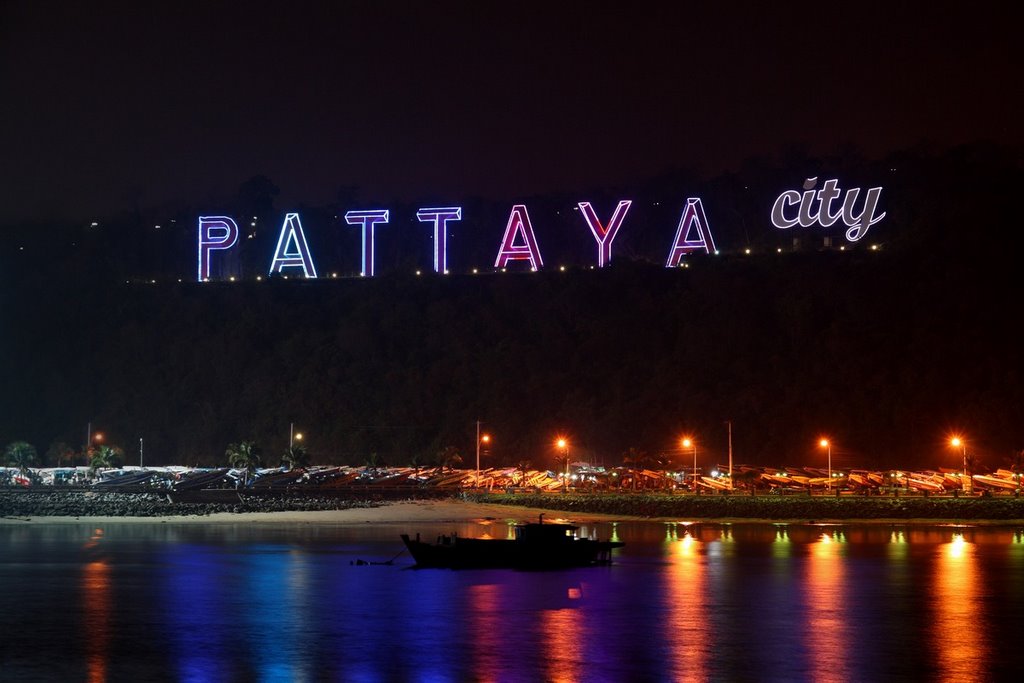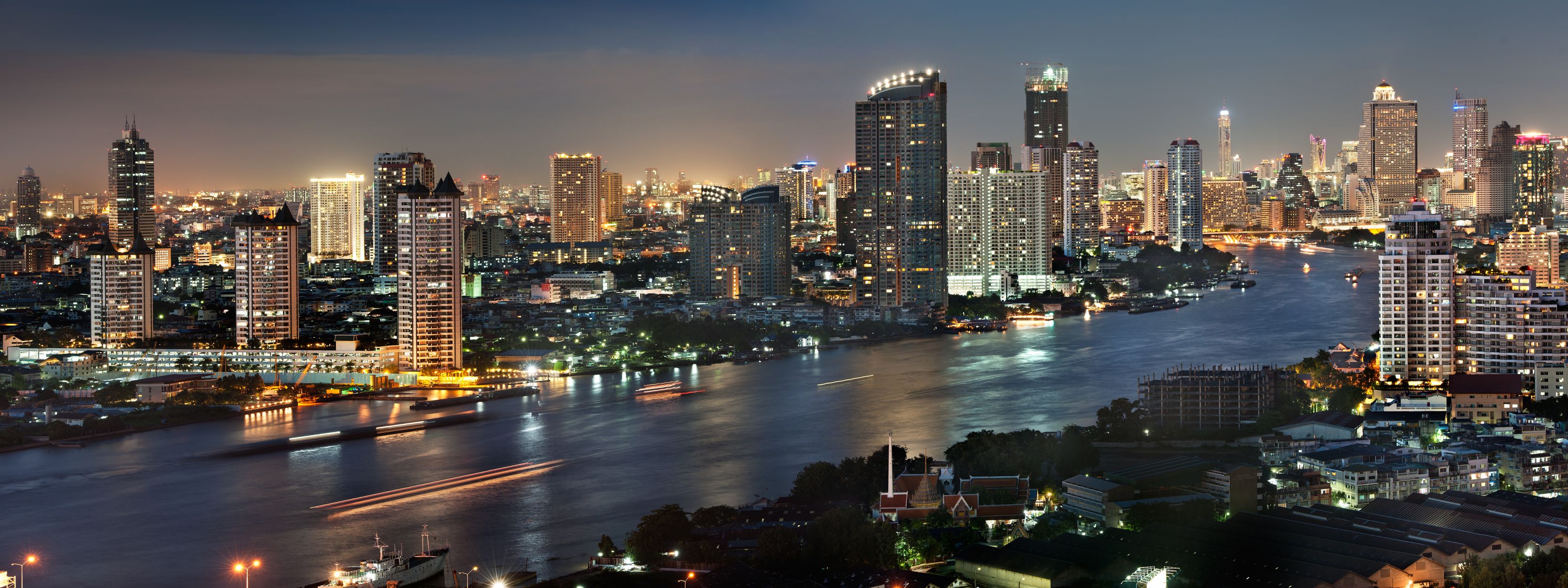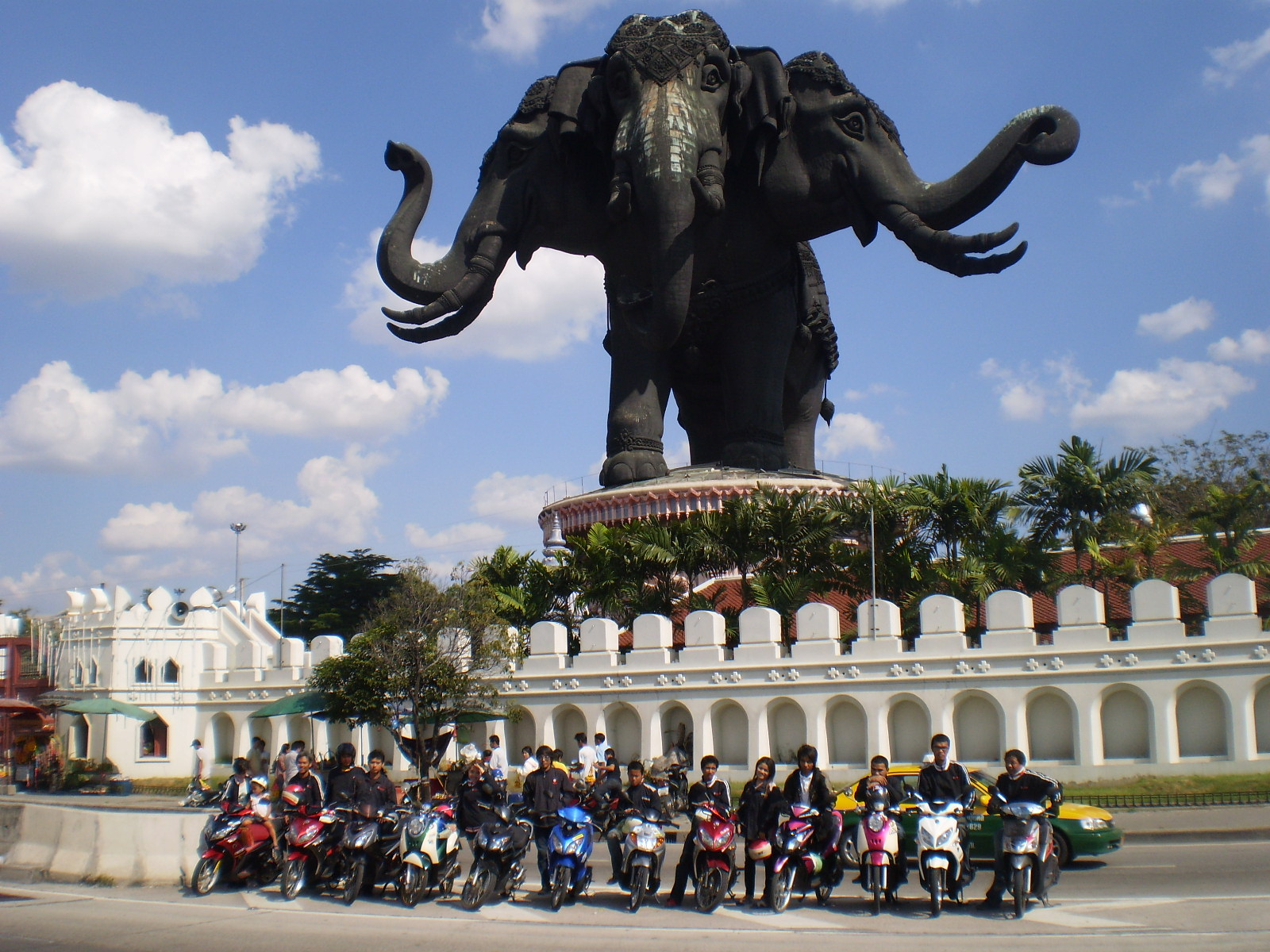Of all the feasts and festivals in Thailand, which are many, the Songkran Festival is the most striking, for it is widely observed not only in this country but also in Burma, Cambodia and the Lao State.
Songkran is a Sanskrit word in Thai form which means the entry of the sun into any sign of the Zodiac. But the Songkran in this particular instance is when the sun enters the sign of Aries or the Ram. Its full name is Maha Songkran or Major Songkran to distinguish it from the other ones. But the people call it simply the Songkran for it is the only one they know and in which they take interest. It is their traditional New Year when they can enjoy their holidays to the full with no economic hindrance. Songkran is a fixable feast on the solar calender. It begins on the 13th April and ends on the 15th April, but occasionally in certain years on the 16th April. The Songkran is in fact the celebration of the vernal equinox similar to those of the Indian Holi Festival, the Chinese Ching Ming, and the Christian Festival of Easter. The beginning of spring when the sun crosses the equator is now on the 21st of March which is due to the precession of the equinox. The Songkran Festival is in a certain sense like April Fool’s Day, when the maids of the village play pranks on any gallant who happens to pass by their way. He will be caught and bound by the united strength of the maids and they will daub him with blacking.
Origins of Songkran
There was once a young man who was prodigious in learning. He understood even the language of the birds. This excited the jealousy of Kabil Maha Phrom, one of the gods of a higher heavenly realm. He came down to meet the young man and posed him three sphinx-like riddles with the wager that if the young man failed to give the right answers within seven days, he would lose his head but if he succeeded, the god himself would give his own. Like all folk tales the young man was at first at his wit’s end to answer such difficult riddles and he repaired to a certain place in order to kill himself rather than face defeat.
He stopped at the foot of a tall tree at the top of which was an aerie. By chance he heard the mother eagle comforting her eaglets who cried for more food, that they would be gratified soon by feasting on the body of the young man who would fail to solve the riddles. She then related the story of the wager between the god and the young man, and in answer to her children’s question the mother eagle satisfied them with the right answers to those three riddles. The young man availed himself of this information and on the appointed day he gave the god the three right answers.
The god, as was the case in such tales, lost the wager and himself cut off his own head. His head was a terrible one for if it touched the earth there would be a universal conflagration and if it fell into the sea, the sea would dry up through its intense heat. The god’s head therefore was deposited in a certain cave in the heavens. Every new year that is on Songkran Day one of the god’s seven daughters in turn will carry her father’s head in procession with millions of other gods and goddesses circumambulating like the sun round the Meru, the Buddhist Olympian Mount. After that there are feasts among the celestial beings who enjoyed themselves with drinks made from the juice of the chamunad creeper. The god’s head was taken back to the cave after the feast, to be taken out again on Songkran day the next year.
Nang Songkran
The seven daughters of Kabil Maha Phrom, the god who lost his head as a wager, have their own names, but they are called as a class Nang Songkran or the Songkran Ladies. When any one of them appears in a Songkran Day parade, she rides on a certain kind of animal, seven in number and she rides it in four different postures according to the time she comes. She stands on the animal’s back if she comes in the morning rides on its back if she comes in the afternoon, reclines with her eyes open if she comes in the evening, and reclines with her eyes closed if she comes past midnight. All these are based on calculations made by court astrologers. For instance, in the year 1951, the Songkran Lady named Kimitha appeared on the 13th April at 1 o’clock 17 minutes and 56 seconds in the morning. She reclined with her eyes closed on the back of a buffalo. The time she appears is when the sun first enters the sign of Aries which heralds the beginning of Songkran New Year’s Day.
Every year before the advent of Songkran the royal astrologer will present his calculations to the King giving all traditional information as predicted by the calculations of the coming year. The artist attached to the court will also paint a picture based on the above information, showing the Songkran Lady and the celestial procession of the god’s head. This painting with such information is hung in a convenient and conspicuous place in the Royal Palace precincts for the people’s information. This traditional practice was given up many years ago, but still survives in old style printed calender sheets which find a ready demand among the folk. The four postures of the Songkran Lady on the back of her animal according to the time when she first appears as a herald of the New Year, was in the old days, a wise one. The people who were mostly illiterates were able to see at a glance when the New Year or Songkran Day begins. When they see the Songkran Lady reclining with her eyes closed on the back of a buffalo, for example, they know at once that Songkran Day will start past midnight. In such a case there will be four day’s celebration instead of three as in other pictures. A picture is more easily retained in memory than a number of figures.
How to celebrate Songkran
On the eve of Songkran Day, i.e. on the 12th April, the people clean their house and burn all the refuse. This is a Spring Cleaning Day done as a duty in the belief that anything bad belonging to the old year will be unlucky to the owner if left and carried on to the coming New Year. It is something like a Public Health Cleaning Day but backed by traditional belief has proved more effective to emotional people than prosaic reason.
Early on the first day of Songkran, the 13th April, the people both young and old in their new clothing go to the Wat or monastery belonging to their village or district to offer food to the monks there. A long table is erected in the compound of the wat where monk’s alms bowls stand in a row on either side of the table. Into the alms bowls the gathering people put boiled rice and into the covers of the alms bowls, food, fruits and sweetmeats. Such a performance can be seen at wats outside Bangkok on Songkran Day. While the monks partake of their feast, music sometimes is played to celebrate the occasion.
In the afternoon of the same day there is bathing ceremony of the Buddha images and also of the abbot of the wat. After this begins the well-known “water throwing feast”. The bathing of images is done as ritualistic ceremony, but it is no other than a New Year’s purification. Younger people will also on this day or the succeeding days go to pay their respect to and ask blessings from their elders and respected persons. They will pour scented water into the palms of the old people and present them with a towel and other bathing requisites. In the old days it was an actual bathing where the young people helped the old people to take a bath and to change their old clothing and put on the new clothes which the young people presented them as an act of respect to the aged on the occasion of the New Year.
Another duty to be done during the Songkran Festival is a religious service called Bangsakun performed in sacred memory to the dead. When a person died and was cremated, the ashes and charred bones of common people were buried at the root of a sacred fig-tree in a wat. Such trees are to be found in the grounds of almost every wat. It is a symbol of the Lord Buddha’s enlightenment for under such a tree did Buddha sit in meditation and receive his enlightenment. If a person is able to erect a Pra Chedi or pagoda in the wat the ashes and bones are then deposited in it. In later times a portion of the bones was sometimes kept in the house in a receptacle. On Songkran Day a religious service in sacred memory to the dead may be officiated by a monk or monks at the place where the ashes and the bones have been deposited, or as in some localities the people bring their dead bones to a village wat in company with others where a joint memorial service is performed. In some parts of the country the guardian spirits of the village and town receive also their annual offerings on Songkran Days. Obviously there are reminiscences or traces of ancestor and animistic worship in by-gone days.
Bathing ceremony
During the three days of Songkran people flock to the wat in their best clothes. They bring with them candles, joss sticks, flowers and small bottles of Thai scented water called “nam ob” or water saturated with perfumes. At the wat shrine each devotee lights a candle and three joss sticks and places them together with a single flower or a bouquet in a receptacle in front of Buddha’s altar.
The worshipers then make obeisance to the Buddha by partly prostrating themselves thrice before His image in a prescribed form. Each worshiper kneels with his hands placed palm to palm raising them to the forehead in a worshipful attitude and then prostrates himself on the floor with the hands now separated to allow the forehead to touch the floor between the palms. Such salutation is called “benchangapradit” from the Sanskrit “panchangapratishtha” (fivefold body worship, i.e.. with the forehead, two palms and two knees resting on the floor). Such salutation among the Thai is the highest form of respect. Salutation by full prostration on the ground and “kissing the earth with the forehead” is unknown.
After worshiping in this manner, a little quantity of the scented water is poured on the hands of the Buddha image. Such a ritualistic act is called in Thai “Song Nam Phra Putha Rup” (bathing the Buddha image.)
Not only do the Buddha images in Thailand receive the ceremonial bath, but elders of the family and elder monks may receive it too. Here is an account of the bathing of family elders. In Bangkok, especially among the upper class, people are want to make a traditional call on their elders to pay their respects during Songkran. This they do by pouring scented water into the palms of the elder who will then duly rub it lightly on his head and face. The elder, in the old days, would then be presented by the visitors with a “phanung” (loin cloth) and a “pha khao ma” for a male or a “pha hom” for a female, both of which constituted everyday wear in those days.
Nowadays the elder is presented with a towel, a box of handkerchiefs, a box of soap or other such articles and sometimes with a bottle of scented water. After the presentation the elder will bestow his blessing and best wishes upon the relatives for the New Year.
A gift of a bottle of scented water is specially appreciated by the older generation who are want to smear themselves during the hot season with a preparation of soft chalk powder called “din saw phong” mixed with scented water which is refreshing to the skin. Sometimes the powder is ready-mixed with attar of roses and may be applied lightly with a towel or handkerchief. Such toilet preparation is called “paeng sod” or fresh toilet powder.
In the old days, the ceremonial bath was the regular family thing. The elder would seat himself on a broad bench. The children would assist him in the bathing by pouring the scented water on him. They also would furnish him with a new set of clothing to be worn after the bath. Further they would present him with the traditional candles, joss sticks and flowers emblems denoting the highest respect among the Thai.
We now come to the ceremonial bath of a monk. It may take place on any of the three days of Songkran. The monk is usually the abbot of the monastery, who is invariably held in high esteem, usually old and, in the case of a village wat, a leading personage in the community life. People call him “Luang Phaw” (Great Father). He is not only their spiritual father but also their adviser in temporal affairs in the light of his recognized wide knowledge and experience. Sometimes he combines the versatility of doctor, astrologer and adapt in the mystical and magical arts separately or all rolled into one.
He is always an unquestioned mediator in disputes; the villagers, in most cases prefer to abide by their “Luang Phaw’s” decision rather than report to the courts or other local authorities.
It is not difficult to see, therefore, that such a man would command hosts of disciples falling over each other to do him the traditional honor of a ceremonial bath. But in such cases a notice is circulated before-hand specifying the exact day and time of the ceremony which is the same as for the elder of a family. After the bath the abbot gives a sermon followed by his blessing for a happy New Year.
Building sand pagodas
It has been the custom in some wats to hold a festival of building “phrasai.” Phrasai” is an abbreviated form of “phra chedi sai” (sand-pagodas). ” Phrachedi” means pagoda and “sai” sand. This festival takes place on an open space in the wat. The sand to be used for the occasion is provided by the wat and piled up nearby. The pagoda builders, mostly women and children, will come to the wat in their best clothes. They will buy candles, joss sticks, flower and banners from the wat stalls set up in the compound. Buying these articles from the wat is regarded as “tham bun” (“merit making”). Some will bring along these requisites, but nevertheless, they will contribute money to “tham bun” as well.
Before the people start to arrive, some monks prepare the temple compound with piles of sand. While others make the flags that will be stuck in the “sand pagodas”.
The merit makers will then fetch sand in the silver bowls which they have brought along with them and carry them to the ceremonial ground and start building a sand pagoda something like a pyramid. The size of the pagoda is optional. The sand is mixed with water to make it lump together when used to build the pagoda. A coin and and a leaf of the religious fig tree will be buried inside the sand pagoda. When finished the pagoda is sprinkled with scented water and decorated with flags and banners. The base of the pagoda is then covered with a small piece of yellow or red cloth. Lighted candles and joss sticks and flowers are stuck around the sand pagoda as an offering. Some of these pagodas, usually the big ones, are beautifully decorated with miniature ceremonial latticed fences surrounding them.
Once the “sand pagodas” are finished, lighted joss sticks are placed in the sand as well as flags with money attached to the stem. As the joss sticks are placed into the sand, the builders say a small prayer.
Sometimes people vie with each other in building such pagodas. The ceremonial ground itself is decorated with ceremonial latticed fences called “rachawat” and banners. There is a theatrical performances in the wat on that day for the merit makers to enjoy themselves. It is a one-day festival and the wat benefits by the sand which the devotees bring. For it serves to raise the level of the ground which normally is too low during the flood season. As the open ground in the wat also serves as a meeting place for the community during the religious and festive occasions, it is ultimately the public in general who benefit by this religious custom.
Building the “sand pagodas” is a family event that goes on all afternoon. As the sun goes down, everyone stops and a prize is given to the best “sand pagoda”.
The sand pagodas do not last long. Unless they are jealously guarded, mischievous children will take pleasure in prying them open and thus ruining them in order to get the coins inside. The bigger ones are usually the selected targets.







